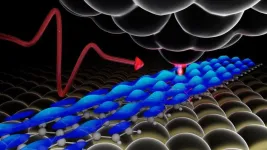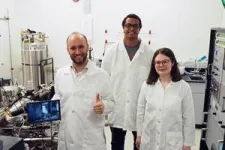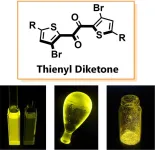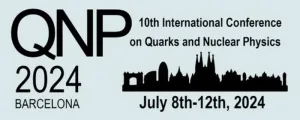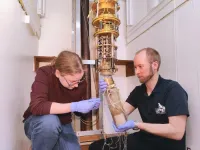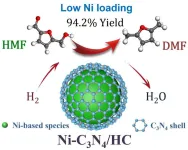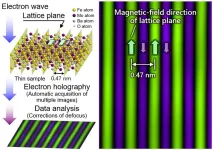(Press-News.org) One of the challenges of cramming smarter and more powerful electronics into ever-shrinking devices is developing the tools and techniques to analyze the materials that make them up with increasingly intimate precision.
Physicists at Michigan State University have taken a long-awaited step on that front with an approach that combines high-resolution microscopy with ultrafast lasers.
The technique, described in the journal Nature Photonics, enables researchers to spot misfit atoms in semiconductors with unparalleled precision. Semiconductor physics labels these atoms as “defects,” which sounds negative, but they’re usually added to materials on purpose and are critically important to the performance of semiconductors in today’s — and tomorrow’s — devices.
“This is particularly relevant for components with nanoscale structures,” said Tyler Cocker, the Jerry Cowen Endowed Chair in Experimental Physics and leader of the new study.
That includes things like computer chips, which routinely make use of semiconductors with nanoscale features. And researchers are working to take nanoscale architecture to an extreme by engineering materials that are a single atom thick.
“These nanoscopic materials are the future of semiconductors,” said Cocker, who also leads the Ultrafast Terahertz Nanoscopy Laboratory in the Department of Physics and Astronomy at MSU. “When you have nanoscale electronics, it’s really important to make sure that electrons can move the way you want them to.”
Defects play a big part in that electron motion, which is why scientists like Cocker are keen to learn precisely where they are located and how they behave. Cocker’s peers have been excited to learn that his team’s new technique will let them easily obtain that information.
“One of my colleagues said, ‘I hope you went out and celebrated,’” Cocker said.
Vedran Jelic, who spearheaded the project as a postdoctoral researcher in Cocker’s group and is now with the National Research Council Canada, is the new report’s first author. The research team also included doctoral students Stefanie Adams, Eve Ammerman and Mohamed Hassan, as well as undergraduate researcher Kaedon Cleland-Host.
Cocker added that the technique is straightforward to implement with the right equipment and his team is already applying it to atomically thin materials like graphene nanoribbons.
“We’ve got a number of open projects where we’re using the technique with more materials and more exotic materials,” Cocker said. “We’re basically folding it into everything we do and using it as a standard technique.”
A light (almost) touch
There are already tools, notably scanning tunneling microscopes or STMs, that can help scientists spot single-atom defects.
Unlike the microscopes many folks would recognize from high school science classes, STMs don’t use lenses and light bulbs to magnify objects. Rather, STMs scan a sample’s surface using an atomically sharp tip, almost like the stylus on a record player.
But the STM tip doesn’t touch the sample’s surface, it just gets close enough so that electrons can jump, or tunnel, between the tip and the sample.
STMs record how many electrons jump and where they jump from, along with other information, to provide atomic scale information about samples (thus, why Cocker’s lab refers to this as nanoscopy instead of microscopy).
But STM data alone isn’t always sufficient to clearly resolve defects within a sample, especially in gallium arsenide, an important semiconductor material that’s found in radar systems, high-efficiency solar cells and modern telecommunication devices.
For their latest publication, Cocker and his team focused on gallium arsenide samples that were intentionally infused with silicon defect atoms to tune how electrons move through the semiconductor.
“The silicon atom basically looks like a deep pothole to the electrons,” Cocker said.
Although theorists have been studying this type of defect for decades, experimentalists have not been able to detect these single atoms directly, until now.
Cocker and his team’s new technique still uses an STM, but the researchers also shine laser pulses right at the STM’s tip.
These pulses consist of light waves with terahertz frequencies, meaning they jiggle up and down a trillion times per second. Recently, theorists had shown this is the same frequency that silicon atom defects should jiggle back and forth with inside a gallium arsenide sample.
By coupling STM and terahertz light, the MSU team created a probe that has an unparalleled sensitivity for the defects.
When the STM tip came to a silicon defect on the gallium arsenide’s surface, a sudden, intense signal appeared in the team’s measurement data. When the researchers moved the tip an atom away from the defect, the signal disappeared.
“Here was this defect that people have been hunting for over forty years, and we could see it ringing like a bell,” Cocker said.
“At first, it was hard to believe because it’s so distinct,” he continued. “We had to measure it in every which way to be certain that this was real.”
Once they were convinced the signal was real, however, it was easy to explain thanks to the years of theory work devoted to the subject.
“When you discover something like this, it’s really helpful when there is already decades of theoretical research thoroughly characterizing it,” said Jelic, who, along with Cocker, is also a corresponding author on the new paper.
Although Cocker’s lab is at the forefront of this field, there are groups around the world currently combining STMs and terahertz light. There are also a variety of other materials that could benefit from this technique for applications beyond detecting defects.
Now that his team has shared its approach with the community, Cocker is excited to see what other discoveries await.
The project was supported by the Office of Naval Research, the Army Research Office and the Air Force Office of Scientific Research.
END
Single atoms show their true color
2024-07-04
ELSE PRESS RELEASES FROM THIS DATE:
Re-engineering cancerous tumors to self-destruct and kill drug-resistant cells
2024-07-04
UNIVERSITY PARK, Pa. — Treating cancer can sometimes feel like a game of Whac-A-Mole. The disease can become resistant to treatment, and clinicians never know when, where and what resistance might emerge, leaving them one step behind. But a team led by Penn State researchers has found a way to reprogram disease evolution and design tumors that are easier to treat.
They created a modular genetic circuit that turns cancer cells into a “Trojan horse,” causing them to self-destruct and kill nearby drug-resistant ...
Reversing chemotherapy resistance in pancreatic cancer
2024-07-04
Pancreatic cancer is a particularly aggressive and difficult-to-treat cancer, in part because it is often resistant to chemotherapy. Now, researchers at Stanford have revealed that this resistance is related to both the physical stiffness of the tissue around the cancerous cells and the chemical makeup of that tissue. Their work, published on July 4 in Nature Materials, shows that this resistance can be reversed and reveals potential targets for new pancreatic cancer treatments.
“We found that stiffer tissue can cause pancreatic cancer cells to become resistant to chemotherapy, while softer tissue made ...
New organic molecule shatters phosphorescence efficiency records and paves way for rare metal-free applications
2024-07-04
A research team led by Osaka University discovered that the new organic molecule thienyl diketone shows high-efficiency phosphorescence. It achieved phosphorescence that is more than ten times faster than traditional materials, allowing the team to elucidate this mechanism.
Osaka, Japan – Phosphorescence is a valuable optical function used in applications such as organic EL displays (OLEDs) and cancer diagnostics. Until now, achieving high-efficiency phosphorescence without using rare metals such as iridium and platinum has been a significant challenge. Phosphorescence, which occurs when a molecule transitions ...
International summit of experts in nuclear physics at the University of Barcelona
2024-07-04
More than two hundred international experts will take part in the 10th International Conference on Quarks and Nuclear Physics (QNP2024), a scientific summit organized by the UB Institute of Cosmos Sciences (ICCUB), which will be held in the Aula Magna of the Faculty of Biology at the University of Barcelona from 8 to 12 July. This meeting, hosted by the UB for the first time, will bring together world experts in the fields of nuclear physics and hadronic physics to discuss the latest advances in theory, experimentation and technology ...
Clever pupils don’t need to attend academically selective schools to thrive, study finds
2024-07-04
Findings published in a new peer-reviewed paper in the British Journal of Educational Studies challenges the idea that academically selective schools are necessary for clever pupils to achieve good outcomes.
Selective schools are government-funded schools that enrol only the highest performing students. Pupils take a standardized entrance exam, from which the best-scoring are enrolled.
Some argue that selective schools are necessary for bright pupils to reach their full academic potential. Selective schools can ...
Searching for dark matter with the coldest quantum detectors in the world
2024-07-04
One of the greatest mysteries of science could be one step closer to being solved.
Approximately 80% of the matter in the universe is dark, meaning that it cannot be seen. In fact, dark matter is passing through us constantly – possibly at a rate of trillions of particles per second.
We know it exists because we can see the effects of its gravity, but experiments to date have so far failed to detect it.
Taking advantage of the most advanced quantum technologies, scientists from Lancaster University, the University of Oxford, and Royal Holloway, ...
UNSW Sydney's Dr Vaishnavi Ananthanarayanan receives RMS Award for Life Sciences
2024-07-04
This accolade highlights her pioneering research in the use of a diverse array of advanced microscopy techniques to uncover fundamental biophysical processes.
Currently holding a prestigious EMBL (European Molecular Biology Laboratory) Australia Group Leader fellowship, Dr Ananthanarayanan leads one of the largest and most dynamic research group in the EMBL Australia Node in Single Molecule Science, based in the Department of Molecular Medicine in the School of Biomedical Sciences.
Her research, which focuses on motor proteins and cytoskeleton dynamics, has set new standards ...
Researchers unveils a critical role of the lateral septum in drug addiction
2024-07-04
Recently, a research team led by Dr. ZHU Yingjie from the Shenzhen Institute of Advanced Technology, Chinese Academy of Sciences has published a study in Neuron, the study presents a comprehensive transcriptional profile of the lateral septum (LS) at the single-cell level, elucidating the spatial distribution of its major neuronal types. The study shows that neurons expressing estrogen receptor 1 (LSEsr1), predominantly located in the ventral subregion of LS, play a crucial role in reward-seeking and methamphetamine (METH) addiction.
In 1954, psychologists Olds and Milner discovered the brain's reward system through intracranial ...
Efficient hydrogenolysis of 5-hydroxymethylfurfural over Ni-C3N4 catalysts
2024-07-04
Utilization of biomass as the basic feedstock for the production and chemicals and energy storage has been demonstrated to be an important alternative to achieve sustainable society, which has attracted increasing interests in both academic and industrial communities for decades. 5-hydroxymethylfurfural (HMF), one of the most important bio-based platform compounds, could serve as a bridge feedstock between biomass resources and chemicals. It is possible to synthesize a series of high-value added chemicals from HMF through hydrogenation, ...
Hitachi’s holography electron microscope attains unprecedented resolution
2024-07-04
Tokyo, Japan—A research team from Japan, including scientists from Hitachi, Ltd. (TSE 6501, Hitachi), Kyushu University, RIKEN, and HREM Research Inc. (HREM), has achieved a major breakthrough in the observation of magnetic fields at unimaginably small scales. In collaboration with National Institute of Advanced Industrial Science and Technology (AIST) and the National Institute for Materials Science (NIMS), the team used Hitachi’s atomic-resolution holography electron microscope—with a newly developed image acquisition technology and defocus correction algorithms—to visualize ...
